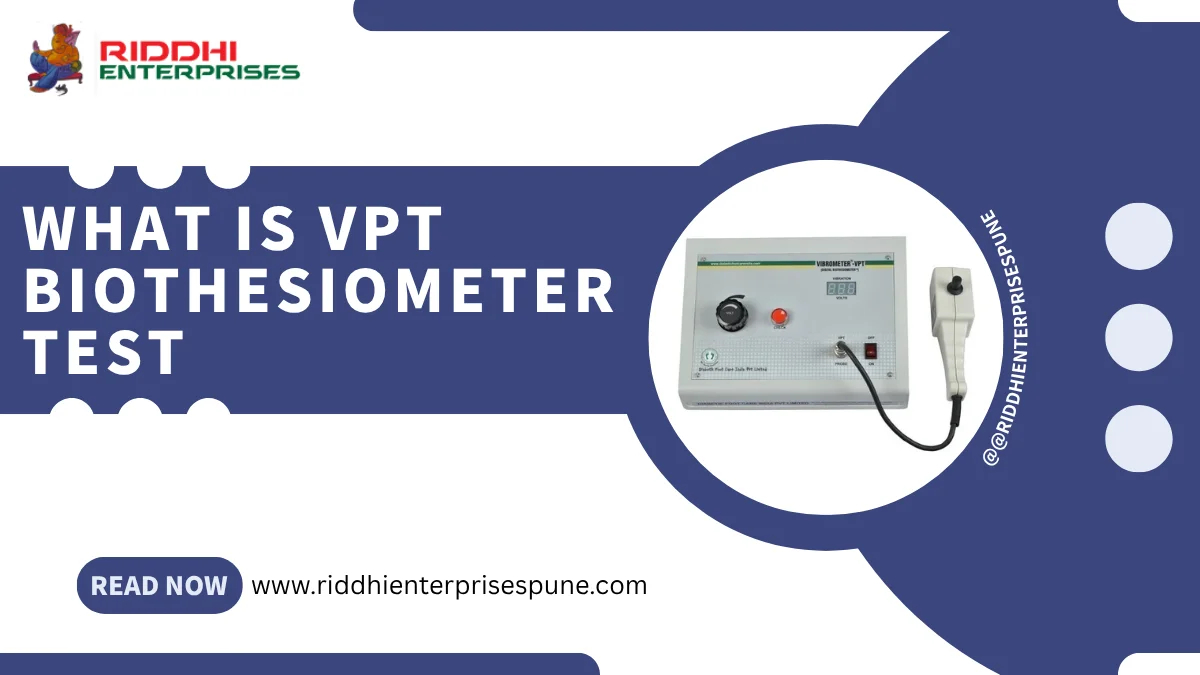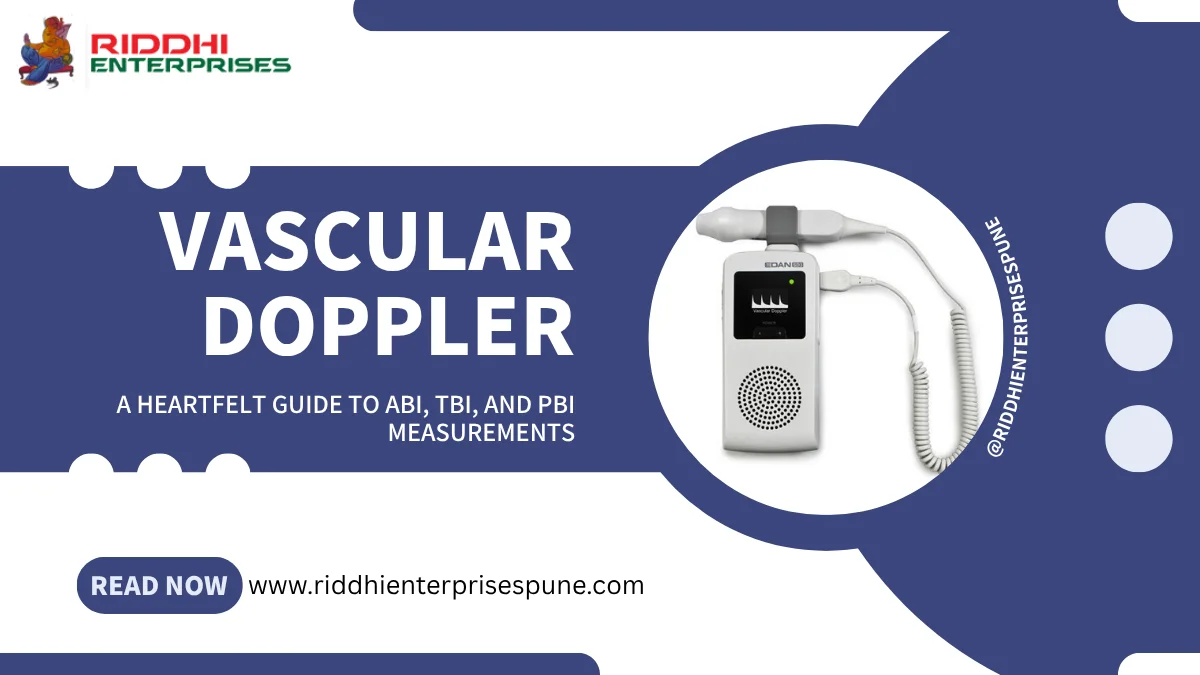-
Welcome To Riddhi Enterprises
-
Our Opening Hours Mon- Fri - 10AM - 6PM
What is VPT Biothesiometer Test

What is VPT Biothesiometer Test
Last week, Mrs Rao strolled into my Pune clinic wearing her favourite bright pink chappals. She glanced at the little device on my desk and asked, “Will that buzzy thing tickle or hurt?” I laughed and said, “Think of it as a gentle hum, almost like your old radio coming to life.” (I know, sounds odd, but bear with me.) Simba—our clinic cat—was napping under the footrest, oblivious to the science about to happen.
What Makes the Biothesiometer So Important?
The biothesiometer test procedure (or “tingle threshold check,” as I sometimes joke) measures how softly your nerves can pick up vibration. Under 50? 1–10 volts is your sweet spot. Over 50? Stretch that to 1–15 volts. Anything above 25 volts means your nerves are whispering warnings, and you need to act fast.
Why do we do the Biothesiometer Test Procedure?
So… here’s the thing about nerve damage in diabetes: it’s like frayed telephone wires. Messages go haywire you mightn’t feel a pebble in your shoe until you’re limping in pain. Almost half of long-term diabetics have this silent nerve damage. That’s why I rely on the biothesiometer test procedure to sniff out trouble before it even whispers.
A Tangled Tale of Early Detection
Mr Joshi came in last month, swore his feet felt “fine enough.” Then his VPT popped to 22 volts. He blinked. “But I feel nothing odd,” he said. Turns out, that mild neuropathy was only the beginning. We tweaked his diet, added extra foot checks after his morning chai break, and custom insoles. Three months later? VPT is safely back under 15 volts. Go figure.
The Biothesiometer Test Procedure, Unpacked
- You kick off your shoes and settle into a cushioned chair, no fancy gown required.
- I wipe your foot with an alcohol pad so the probe glides like butter.
- I tap the probe on three zones: big toe, arch, and heel. (Yes, three spots—precision matters!)
- The machine hums… it tickles… You say “buzz” when you feel it. Almost like the faintest hum of a scooter at dawn.
- We repeat thrice per spot. Average those numbers, and voilà—your VPT score.
- No needles. No jolts. Just a little vibration that tells us a lot.
Decoding the Biothesiometer Normal Range
- Under 50 years old? 1–10 volts = normal, 11–15 mild, 16–20 moderate, 21–50 severe.
- Over 50? 1–15 = normal, 16–20 mild, 21–25 moderate, 26–50 severe.
Don’t get hung up on numbers. Focus on feeling if you’re above 25 volts, your nerves need some serious TLC.
When to Schedule Your Test?
- Type 2 diabetes? Right at diagnosis, then yearly.
- Type 1 diabetes? Five years after diagnosis, then yearly.
- Wild blood sugars or past elevated VPT? Check every six months.
Turning Your VPT into Action
- VPT in normal range? Keep rocking your balanced meals, daily walks on soft grass (yes, barefoot!), and stable glucose levels.
- Mild neuropathy? Mirror foot inspections after shower, tighten your sugar targets, and slip into cushy footwear.
- Moderate/severe neuropathy? Time for podiatry referrals, custom diabetic shoes, and possible med tweaks.
Wild Clinic Anecdote
Full disclosure, I once misread the scale and panicked when Mrs Patel’s VPT showed 50 volts. Turned out I forgot to reset the dial. She still teases me about that “dramatic spike.” Lesson learned: double-check your settings!
Simple Prevention Tips
- Treat foot care like a mini spa: wash, massage, inspect—every single morning.
- Swap socks for moisture-wicking ones, and chappals for supportive shoes.
- Stroll barefoot on soft grass after your evening chai—your nerves will thank you.
- Aim for HbA1c under 7 per cent—tiny dips there yield big nerve health gains.
- Tackle blood pressure, cholesterol, and quit smoking. Every little bit helps.
Quick Comparison: Biothesiometer vs. Monofilament
Monofilament misses nearly one in three nerve issues. Our buzzing probe? It gives clear numbers you can act on no guesswork.
Alright, that’s my spiel. Go feel that buzz seriously.
FAQs
Q1: Does the biothesiometer test procedure hurt?
Nope. Most folks laugh at how odd it feels, a gentle hum or tickle, nothing more.
Q2: How quickly do I get my VPT results?
Right away. We average three readings per spot and discuss them on the spot—no waiting around.
Q3: What can skew my VPT reading?
Age, B12 levels, thyroid issues, and even certain meds. Always tell me everything you’re taking—yes, that includes vitamin D.
Q4: How often should I repeat the test?
Once a year is standard. If your sugar control’s wobbly or your last VPT was high, shoot for every six months.
Q5: Will insurance cover this testing?
Many plans and Medicare cover diabetic foot exams, including VPT. Just check your policy’s fine print or ask your insurer to explain it to you.
Related Blogs

What is VPT Biothesiometer Test
Posted On 06 Oct 25

Vascular Doppler Measurements Guide
Posted On 03 Oct 25


